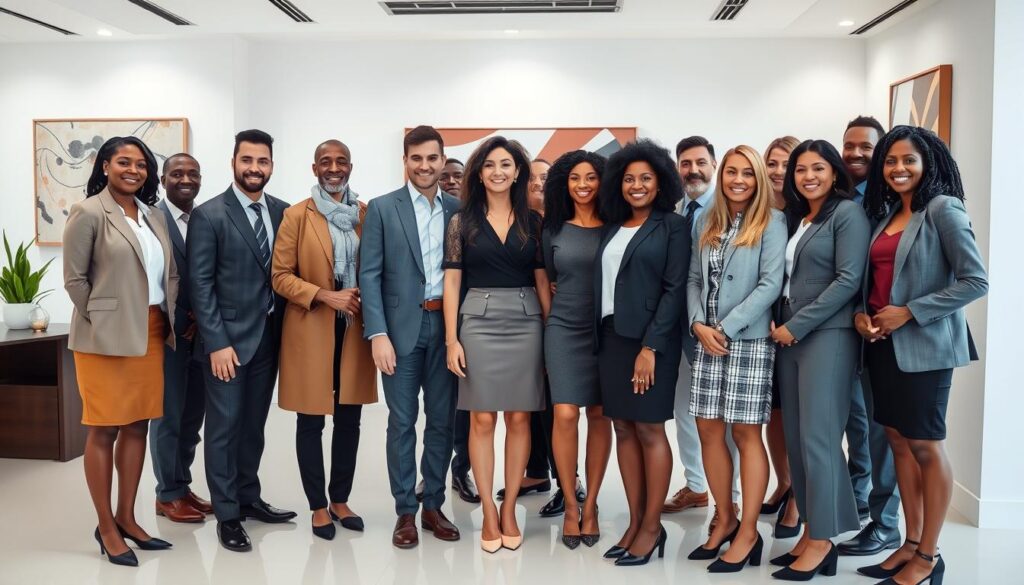How to make job interviews more inclusive

Making job interviews inclusive is key to a diverse and fair workplace. In today’s world, diversity hiring is more than just a trend. It’s about educating hiring teams and changing how we interview.
This approach helps fight unconscious biases and brings in a more diverse group of candidates. It ensures everyone has a fair chance, regardless of their background. By taking these steps, companies can create a place where everyone can succeed.
Stay with us as we explore practical ways to make job interviews more inclusive.
Understanding the Importance of Inclusive Job Interviews
Creating an inclusive hiring process is key for following anti-discrimination laws and boosting a company’s image. By using anti-discrimination interviewing methods, businesses can draw in a diverse range of talents. This helps in reducing biases.
Structured interviews, as suggested by Harvard Business Review, help ensure fairness. Each candidate brings their own experiences and views, making the team stronger and more diverse. In fact, diverse teams are 87% better at making workplace decisions.
Using neutral language in job ads and interviews is also vital. Companies should avoid language that could be seen as discriminatory. They should not list physical requirements unless they are essential for the job. This approach makes hiring more inclusive, welcoming candidates with disabilities.
Offering accommodations like sign language interpreters or Braille applications during interviews is helpful. When doing background checks, focus on what’s relevant to the job. This way, no candidate is unfairly judged.
By embracing these inclusive practices, companies not only follow the law but also show they value diversity. This attracts a wide range of talents, leading to innovation and growth.
Creating Inclusive Job Descriptions
Creating inclusive job descriptions is key to successful hiring. Start by using neutral language in your job postings. Avoid jargon or terms specific to your industry. This helps attract a wider range of candidates.
It’s important to show your commitment to diversity hiring. Include statements about your company’s dedication to diversity and inclusion. These statements show your values and welcome diverse applicants.
Also, highlight the support systems you offer. Mention Employee Resource Groups or mentorship programs. This can attract candidates from underrepresented groups and make them feel supported from the start.
Here’s a quick overview of what to include in inclusive job descriptions:
- Neutral and clear language
- Specific statements on diversity and inclusion
- Highlighting support systems like Employee Resource Groups
Building a Diverse Interview Panel
A diverse interview panel is key to a successful hiring process. Why is this important? It helps avoid unconscious bias, ensuring fair treatment for all candidates, no matter their background.
When candidates meet a variety of perspectives, they feel more comfortable. This comfort can improve their performance. It’s good for both the hiring process and the company’s image. Diverse panels also offer a wide range of experiences and views. This leads to more thorough and fair evaluations of candidates.
Here’s a table showing how a diverse panel can change the recruitment game:
| Aspect | Benefit |
|---|---|
| Diverse Perspectives | Provides varied viewpoints, leading to a more balanced assessment of candidates. |
| Reduction of Bias | Helps in mitigating unconscious bias, fostering an inclusive hiring process. |
| Candidate Comfort | Places candidates at ease, allowing them to perform better during interviews. |
| Company Branding | Projecting an inclusive workplace, attracting top talent from various backgrounds. |
In the end, a diverse interview panel is crucial. It ensures every candidate can show their best. This approach not only improves hiring but also shows the company’s dedication to diversity and inclusion.
Standardizing Your Interview Process
Creating a standard interview process is key to ensuring fairness in job interviews and equal opportunities. It helps companies evaluate candidates without bias. This way, everyone is treated equally.
Using the same questions for all candidates is a smart move. It lets employers compare them fairly, based on skills and abilities. For example, a structured interview with scorecards for each trait ensures fairness.
Also, having a diverse interview panel helps evaluate candidates better. It makes them feel more at ease and reduces biases. It’s important to have a balanced panel with different views.
Standardizing interviews also promotes equal opportunities. It helps avoid unfair advantages from casual chats. For instance, men often talk more about sports with other men during interviews. This shows the need for structured talks to keep things fair.
In summary, a standard interview process boosts fairness in job interviews and creates a welcoming space. Every candidate feels valued and judged fairly.
Training Interviewers to Counteract Bias
To ensure fairness in job interviews, it’s key to train interviewers to spot and fight their biases. They need to understand the value of diversity hiring. This helps make the hiring process fair and inclusive.
Tools like bias training and blind recruitment help a lot. Bias training teaches interviewers about biases and how to avoid them. It gives them tips to make fair choices.
Blind recruitment removes personal info from apps early on. This way, interviewers only see what candidates can do. It makes hiring fairer and supports diversity.
| Aspect | Traditional Recruitment | Blind Recruitment |
|---|---|---|
| Initial Application Review | Includes personal details like name and photo, leading to bias | Excludes personal details, focusing on skills and qualifications |
| Interviewer Bias | Higher risk of unconscious bias affecting decision-making | Reduced risk of bias, promote fairness in job interviews |
| Diversity Outcomes | Often fails to support diversity hiring practices | More likely to support and enhance diversity hiring practices |
Utilizing Structured Interviews
Using structured interviews can change how you hire for the better. By asking the same questions to everyone, you cut down on biases. This way, you focus on what matters most for the job, making sure everyone is judged fairly.
Structured interviews also help with anti-discrimination interviewing. They offer a clear plan that reduces biases from interviewers. This means all candidates get a fair chance to show what they can do.
Studies from Harvard Business School show structured interviews work well for diversity. Using these methods makes your hiring fairer and helps build a diverse team.
When you start using structured interviews, teach your interviewers about being consistent and fair. This is key to anti-discrimination interviewing. It’s a big step towards a more inclusive hiring process.
Best Practices for Video Interviews
Video interviews are now common, and following best practices is key. It makes sure everyone is treated fairly. Start by setting clear rules for everyone.
First, tell candidates about the best lighting and sound. They should use natural light and keep background noise down. This helps them feel more confident.
It’s also important to think about the tech differences candidates might have. Offer video-off calls for those with bad internet or old devices. This makes interviews more inclusive.
Being flexible with schedules and helping with tech before the interview also helps. It shows you care about everyone’s experience. This is part of being inclusive.
Finally, ask for feedback after the interview. This helps spot any unfairness or tech problems. Here’s a quick guide to video interview best practices:
| Best Practice | Description |
|---|---|
| Provide Clear Guidelines | Share tips on lighting, sound, and presentation before the interview. |
| Offer Video-Off Options | Accommodate candidates with limited technology by allowing audio-only calls. |
| Flexibility in Scheduling | Adapt to different time zones and personal schedules for convenience. |
| Pre-Interview Tech Support | Assist candidates in navigating the interview platform to prevent technical issues. |
| Collect Feedback | Regularly review and improve the interview process through candidate feedback. |
Inclusive Recruitment Strategies
Creating effective inclusive recruitment strategies is key for businesses aiming for a diverse workforce. An inclusive hiring process lets companies access a wide range of talents and views.
One important step is to post job ads on various platforms. Use LinkedIn, Indeed, and Glassdoor, plus community job boards and social media groups for minority groups. Also, team up with groups that focus on diversity hiring practices to boost your efforts.
Writing job descriptions that appeal to many candidates is also crucial. Make sure the language is clear and inclusive. Avoid biases that might scare off candidates from diverse backgrounds. Include phrases that show you value equal opportunities and welcome diverse applicants.
Also, connect with communities through job fairs, webinars, and info sessions. This shows you’re serious about diversity. It not only attracts diverse talent but also makes your company a top choice in these communities.
| Action | Benefit |
|---|---|
| Advertising in diverse media | Reaches a wider and varied candidate pool |
| Partnering with diversity organizations | Strengthens pipeline of underrepresented talent |
| Inclusive job descriptions | Encourages applications from diverse groups |
| Community engagement | Builds reputation as an inclusive employer |
Crafting Purposeful Interview Questions
Creating thoughtful interview questions is key to ensuring fairness in job interviews. These questions should focus on the skills needed for the job. By avoiding personal questions, interviewers can stay objective and fair. This method fits well with structured interviews, giving all candidates a fair chance to show their skills.

For example, instead of asking about past experiences, use situational questions. These questions help candidates show their problem-solving and adaptability. This way, you get a better look at how they might do in the job. Here are some examples:
| Traditional Question | Purposeful Question |
|---|---|
| Can you tell me about a time when you led a project? | Imagine you are leading a project that is behind schedule. What steps would you take to get it back on track? |
| What are your strengths and weaknesses? | How do you handle tasks that stretch beyond your current skill set? |
| Why did you leave your last job? | How do you approach challenges in a team setting? |
By using these types of questions, you can assess candidates based on their relevant skills. This makes your interviews more effective and fair, supporting the use of structured interviews.
Incorporating Work Samples and Assessments
Adding work samples and assessments to interviews is a smart move. It makes sure hiring is fair for everyone. By using real tasks, employers can see if a candidate can do the job. This way, everyone is judged based on what they can do, not just how they talk.
These tasks can be writing tests, coding challenges, or case studies. They let candidates show their skills in real situations. This helps avoid biases that can happen in regular interviews. It’s a great way to make hiring fair for everyone.
| Type of Assessment | Description | Benefits |
|---|---|---|
| Writing Tests | Require candidates to complete a task related to writing, such as drafting an article or a report. | Evaluates language proficiency and coherence in communication. |
| Coding Challenges | Assesses the candidate’s ability to write and understand code through problem-solving exercises. | Tests technical skills and logical thinking under time constraints. |
| Case Studies | Presents candidates with a business scenario, requiring them to propose solutions or strategies. | Measures analytical thinking, decision-making skills, and creativity. |
Using fair assessments helps everyone have a chance. It picks the best person for the job. This way, hiring is based on what you can do, not just who you are. It shows a real commitment to fairness in hiring.
Focusing on Candidate Capabilities
It’s key to focus on what candidates can do, not just who they are. This way, companies can find the best fit for the job. It’s about skills and potential, not just background or who they know.
Using fair interview methods helps everyone have a chance. It’s about looking at what each candidate can do, not who they are. This makes the team more diverse and creative.
- Competency-based questions: Ask about specific skills and situations to gauge how candidates handle various tasks.
- Practical assessments: Use job-related tasks to see real-world application of a candidate’s abilities.
- Behavioral interview techniques: Inquire about past experiences that demonstrate relevant competencies and problem-solving prowess.
By focusing on what candidates can do, companies can improve their team. They create a fair and welcoming place to work.
Ensuring Equal Opportunity Employment
Commitment to equal opportunity employment means making sure everyone is treated fairly. This includes checking hiring practices and training on diversity. It also means having clear rules against discrimination.

To build an inclusive workplace, training is key. It should teach everyone how to avoid bias. All those involved in hiring must take this training. The company also needs to check its hiring methods often to make sure they’re fair.
Having clear rules against discrimination is also important. These rules should be easy for everyone to find and understand. They should be updated often to keep up with laws and company values. This helps make the workplace more welcoming for everyone.
| Commitment Area | Action Required |
|---|---|
| Policy Creation | Develop and enforce anti-discrimination policies |
| Diversity Training | Implement regular training programs on diversity |
| Hiring Practice Review | Conduct regular reviews of hiring practices |
| Policy Communication | Ensure policies are accessible and clearly communicated to all employees |
Building an Inclusive Workplace Culture
Creating an inclusive workplace culture is more than just hiring diverse teams. It’s about making a place where everyone’s voice is heard and valued. Companies can do this by starting mentorship programs, holding diversity training, and making policies that include everyone.
Diversity hiring is a start, but keeping a diverse team takes work. Mentorship programs help new employees fit in and learn from others. Diversity training also helps by teaching employees about different cultures and reducing biases.
Corporate policies should cover everything, from work hours to chances for growth. When companies focus on an inclusive workplace culture, they encourage creativity, teamwork, and respect for all.
Conclusion
Exploring inclusive job interviews and hiring shows their importance. They help create a diverse and successful team. Using structured interviews and training interviewers to avoid bias is key.
Creating job descriptions that welcome everyone is also crucial. Building a diverse interview panel and standardizing interviews makes the process fair. Adding work samples and skills assessments helps compare candidates fairly.
Creating an inclusive workplace culture is just as important. By using these strategies, companies can attract a wide range of talent. This ensures everyone has a chance to thrive and succeed.
